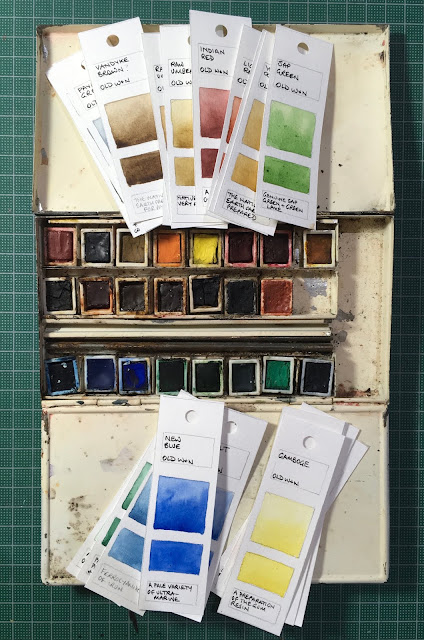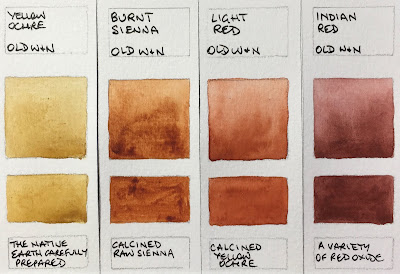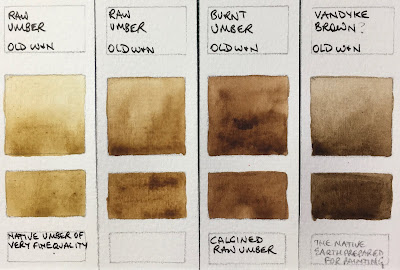 |
| Antique Winsor & Newton 'Japanned Tin Box' palette - closed |
I recently had the opportunity to test out the paints in a paintbox that probably dates back to the from the 1890s. I don't know the exact date nor how recently the paints might have been updated, but it was rather fun to see that mostly they still rewet nicely.
The box is a great size - just under 7" wide (175mm) and a little under 4" deep (98mm). It's about an inch high with the thumb ring and the domes of the mixing wells.
 |
| Antique Winsor & Newton palette |
 |
| Antique Winsor & Newton palette - open. |

The paints are in ceramic half pans, with W&N ENGLAND stamped on the bottom. How lovely! It would be great to be able to get those again...
Some had labels on them, which might help with dating them I suppose.
The colours painted out nicely once any crud was scrubbed off the top. I've used the names that were on the labels where there were labels and guessed otherwise. The information on the bottom of each swatch is from a Winsor & Newton catalogue from perhaps1894 that was with the watercolour box.
Here they are painted out..
The Gamboge was made from the gum resin from Cambodia, and is not lightfast. The second yellow was really lovely. I am guessing it is Cadmium Yellow. Both Rose Madder Alizarin and Alizarin Crimson were far more delicate than I suspect they would originally have been. Rose Madder Alizarin is not mentioned in the catalogue so may date from later years.
 |
| Antique Winsor & Newton Watercolours - Gamboge (genuine), Possibly Cadmium Yellow, Chrome Orange, Rose Madder Alizarin and Alizarin Crimson. |
New Blue is a version of Ultramarine but I am just guessing that the third blue is Prussian Blue rather than cerulean. It paints out rather chalky but looks like Prussian Blue in the pan. It could be Antwerp Blue, which is described as 'a weak variety of Prussian Blue containing Alunina'.
 |
| Antique Winsor & Newton Watercolours - New Blue, Cobalt Blue, possibly Prussian Blue or Antwerp Blue? |
 |
| Antique Winsor & Newton Watercolours - Hooker's Green No 2, Emerald Green, Terre Verte, Sap Green. |
Yellow ochre is a bit of a surprise - not as yellow as I'd have expected as I wouldn't expect this colour to change over the years. Burnt sienna was lovely - I'm sure this is a natural PBr7 version. Light Red and Indian Red are also lovely.
 |
| Antique Winsor & Newton Watercolours - Yellow Ochre, Burnt Sienna, Light Red, Indian Red. |
There were two half pans of raw umber and they were slightly different. It is described as 'Native Umber of very fine quality, and possessing the greenish cast of colour which is much prized by Artists'. The warmer Burnt Umber was there and I am guessing the other is Vandyke Brown - made with 'native earth prepared for painting'
 |
| Antique Winsor & Newton Watercolours - Raw Umber, Raw Umber, Burnt Umber, Vandyke Brown? |
Payne's Grey had already changed rom the original yellow ochre, Prussian blue and crimson lake formula that I understand William Payne devised and was made with Indigo, Cochineal Lake and Carbon Black. The same mix was used for what I assume to be Neutral Tint.
 |
| Payne's Grey, Neutral Tint?, Lamp Black. |
*Quotes are from the Catalogue - 'Winsor & Newton Limited. Manufacturing Artists' Colourmen by special appointment to Her Majesty and to their Royal Highnesses the Prince and Princess of Wales'.
The catalogue is illustrated with wonderful engravings showing some fabulous watercolour boxes and palettes, sketcher's hold-alls, pencil sets, chalk boxes and views inside the factory. Just fascinating!

Very cool!
ReplyDeleteI've bought quite a few vintage pans, some with the ceramic pans, but I've never had the luck you had getting the colors to come out.
ReplyDeleteThat's a nice little pan. There's even room for a brush and a small tube of white and two generous mixing flaps and it holds 24 half pans. What more could you ask for?
What a wonderful find, it's good somebody who would appreciate them got 'em! I mean, these are yours now, aren't they?
ReplyDeleteDon't these colors look like Beatrix Potter's watercolors? That was the first thing I thought of, even before I read your post.
No they are not mine - I have just borrowed them from a friend who knows my passion for watercolour. He'll eventually have the palette re-enamelled and set it up for use with fresh paint.
DeleteCool post and really good information to know.
ReplyDeleteEmerald green = copper aceto arsenite = a deadly poison---more than unhealthy as it's easily fatal. As you know, it was also known as Paris green and was used as a rat poison. It was widely used for years to dye clothes and paint rooms and furniture. People died from it.
Yes I am not usually too worried about watercolour paints but after painting out these swatches I washed my water bowl, brushes and hands very carefully! I once stayed in a room in the south of France with green printed wallpaper that was last decorated in about 1860 or something and I did wonder if it was safe to breathe in there.....
DeleteAnother great post, Jane. The "Prussian" Blue is likely just that, though it looks less dull than some recently manufactured samples. I'm surprised that the Emerald Green is so thin - maybe just too much water? Or did it resist dispersal in the water? [Dangerous stuff though] And the A. Crimson is also surprisingly "delicate", as you say.
ReplyDeleteI scrubbed at the difficult colours with a firm bristle brush to try to get more pigment but this was the best I could do. They may have been different once!
DeleteWhat a great way to get a glimpse of the past. Thank you.
ReplyDelete